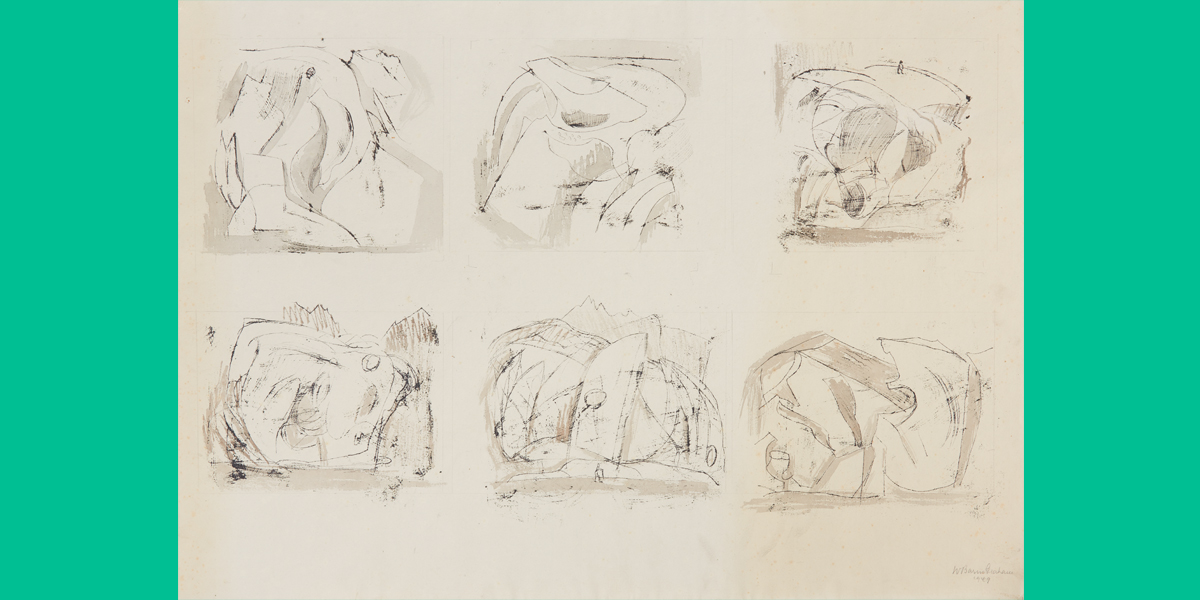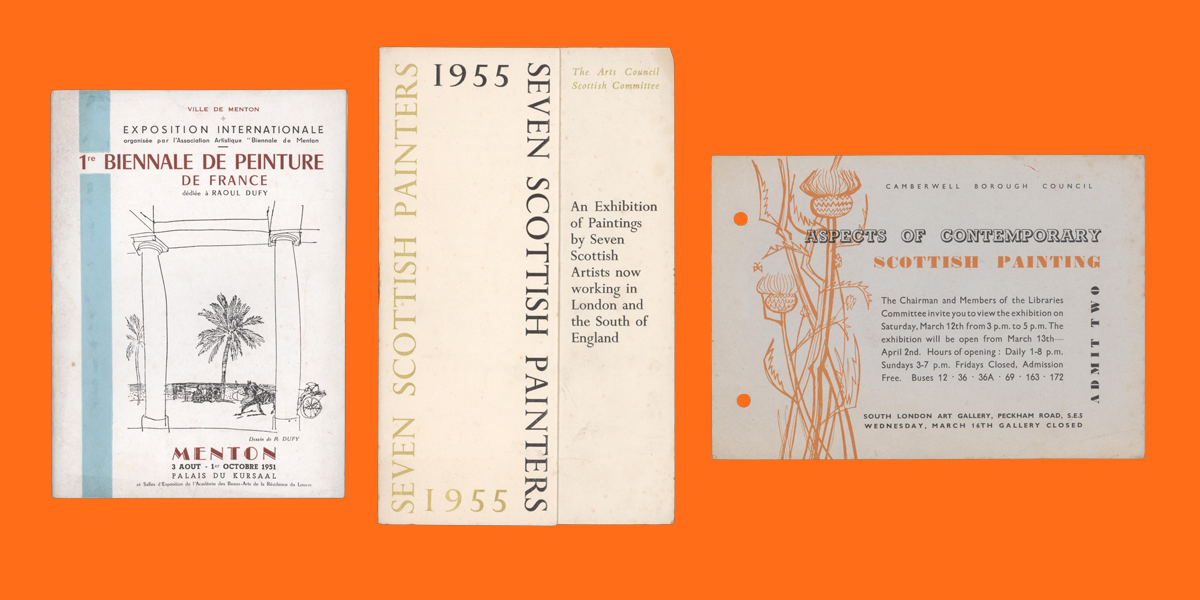Colquhoun, Barns-Graham and MacBryde: Three Scottish artists working in London and the south of England
Wilhelmina Barns-Graham first met the artists Robert Colquhoun and Robert MacBryde, often known together as The Two Roberts, during her student years. When as professional artists at the beginning of the 1940s, they all moved to London and Cornwall, their lives, friendships and careers continued to intertwine. Here we trace their movements in both artistic and friendship circles through our collection and archive.

Drawing of a Horse's Head, n.d. attributed to Robert Colquhoun. Barns-Graham notes in a list of her art collection owning a drawing of a horse's head by Colquhoun.
Exchanges of Art and Friendship
Barns-Graham, Colquhoun and MacBryde began their art education within a year of each other. Barns-Graham, the eldest of the three, entered Edinburgh College of Art in 1932, with the Two Roberts joining the Glasgow School of Art the following year. It was at some point during their studies that the trio met, probably during one of the annual exchanges between the two art colleges, noted by Lynne Green in A Studio Life.
The friendship that blossomed between the three young artists was likely nurtured by the parallel successes they enjoyed in their early careers. As art students, they all achieved recognition at their respective art colleges, and were awarded travelling scholarships to Europe. Friendships shared with the likes of fellow painters William Gear and David Haughton, and poet W.S. Graham would have served as further bridges of connection. So too would the decisions by both Barns-Graham and the Two Roberts to leave their Scottish origins to embark on adventures in St Ives and London in 1940 and ’41, respectively. The latter perhaps the most important, with Colquhoun and MacBryde acting as a point of contact and a link to home during Barns-Graham’s frequent visits to London in the 1940s or an infamous trip by the Two Roberts to wartime St Ives.

Exhibition catalogue for Robert Colquhoun's 1947 exhibition at Lefevre Gallery, WBG/9/737. Barns-Graham has made colour notes on the black and white image of 'The Actors'.
Thunder and Sunshine
Known for hosting wild parties, a night out with the Two Roberts was always likely to be eventful. On one of their visits to St Ives, during a gathering in the pub with John Wells, Sven and Helga Berlin and Nessie and W.S. Graham in attendance, Barns-Graham recalled:

A description of an evening with the Two Roberts in St Ives from Barns-Graham's handwritten note book of Reminiscences, 1993-6, WBG/2/6/1.
there was an instantaneous trauma between my friend Colquhoun and myself the first and only time, I cannot recall now why, maybe I had ignored what he was saying or tried to shut him up anyway in a dare he took his pint of beer and held it above my head and poured it over onto my newly cleaned mustard yellow much admired cord jacket, enraged and humiliated I automatically slapped him on the face, taken aback he quickly said ‘Oh what a woman what a woman’ we both quickly realised the longtime friendship and affection between us, broke with relief the silence to all in the room embraced one another, MacBride [sic] standing beside me with an arm around me. Thunder and sunshine two Scots on fire!
Final transcription of Barns-Graham’s reminiscense of an evening with the Two Roberts (above, WBG/2/6/1)
The dramatic tone for the evening was set. Barns-Graham later moved the party to her Porthmeor studio, attempting to circumvent the wartime blackout, however, this culminated with Colquhoun nearly setting the studio alight, having fallen asleep with a lit cigarette!

Six Glaciers, 1949, offset on paper, BGT7073. This is one of the drawings shown in Barns-Graham's 1949 exhibition at Downing's Bookshop.
An Attractive Way of Drawing
One of the most significant influences of the Two Roberts on Barns-Graham was the introduction to her of the offset drawing technique. Taught to Colquhoun and MacBryde by Jankel Adler (a Polish artist who lived above them in London), offset drawing is a type of transfer drawing where a preparatory image is traced onto another sheet through the pressure of a sharp implement and an intermediary sheet inked up with oil paint or printers’ ink. The technique became popular, particularly in St Ives, during the war years when printing presses were closed, but Barns-Graham returned to it often finding it ‘an attractive way of drawing’. Her regard for the technique can be demonstrated by her choice of this medium for her initial artistic response to the Grindelwald Glacier, presenting a series of offset glacier drawings at Downing’s Bookshop just a month after her return.

Catalogues from the three exhibitions where works by Barns-Graham, Colquhoun and MacBryde were shown together in the 1950s.
Exhibitions Reunited
While their friendship developed through the 1930s and 40s, it was not until the early 1950s that all three artists had works shown together in an exhibition. It was at this time that Barns-Graham was beginning to receive wider recognition for her paintings, the starry success enjoyed by the Two Roberts in the late 1940s, however, was fizzling out. Three major exhibitions reunited the Scots: 1951’s Premiere Biennale de Peinture de France in Menton (making up three of the eight British artists included); Aspects of Contemporary Scottish Painting at the South London Gallery; and Seven Scottish Artists (now working in London and the South of England), both opening in March 1955.

Barns-Graham's membership card for Club de Caves de France (WBG/4/12/1) and a page from Barns-Graham's 1961 diary showing the entry for 21 June (WBG/4/1/12/1)
Soho in the Sixties
When Barns-Graham moved to London in 1960, she took up the opportunity to socialise with the Two Roberts again. We know from a membership card held by Barns-Graham to the Club de Cave de France, located at 39 Dean Street, that she was spending time in London’s Soho. The Two Roberts often frequented the pubs in the area (although they were unlikely to be able to afford memberships to the famed Soho clubs). A final glimpse of their lasting friendship is a note in Barns-Graham’s diary from June 1961, just one year before Colquhoun’s death. On Wednesday 21st, she ‘took RC [Colquhoun] to eat Wimpys’ (!) – the now-international burger chain’s first restaurant was located at the edge of Soho. Having met with the pair, Barns-Graham determined (and given they often lived hand-to-mouth) that Colquhoun needed some food fast.
From the corridors of Scotland’s art colleges, to the glowing lights of Soho in the 1960s, through the ebbs and flows of their artistic careers, Barns-Graham and the Two Roberts remained connected.
